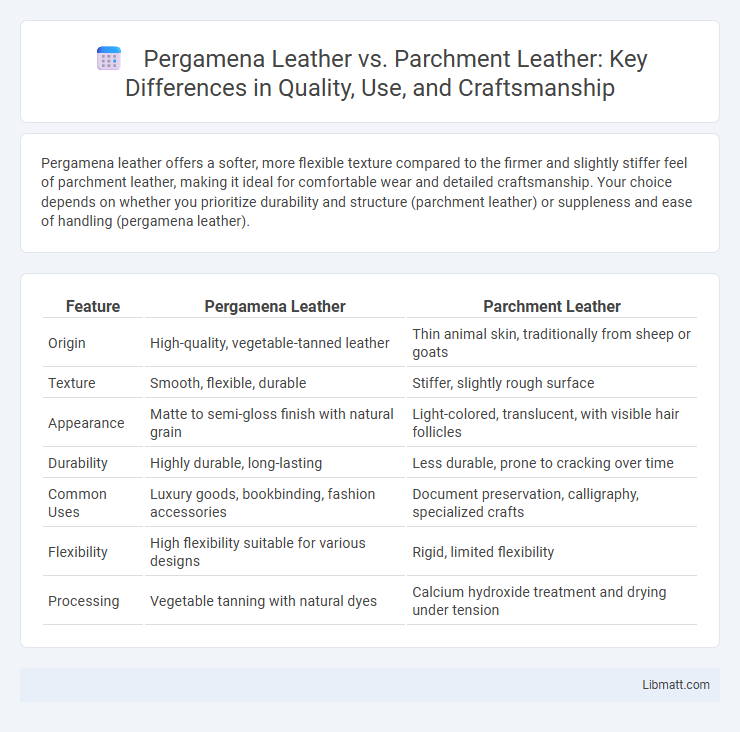Pergamena leather offers a softer, more flexible texture compared to the firmer and slightly stiffer feel of parchment leather, making it ideal for comfortable wear and detailed craftsmanship. Your choice depends on whether you prioritize durability and structure (parchment leather) or suppleness and ease of handling (pergamena leather).
Table of Comparison
| Feature | Pergamena Leather | Parchment Leather |
|---|---|---|
| Origin | High-quality, vegetable-tanned leather | Thin animal skin, traditionally from sheep or goats |
| Texture | Smooth, flexible, durable | Stiffer, slightly rough surface |
| Appearance | Matte to semi-gloss finish with natural grain | Light-colored, translucent, with visible hair follicles |
| Durability | Highly durable, long-lasting | Less durable, prone to cracking over time |
| Common Uses | Luxury goods, bookbinding, fashion accessories | Document preservation, calligraphy, specialized crafts |
| Flexibility | High flexibility suitable for various designs | Rigid, limited flexibility |
| Processing | Vegetable tanning with natural dyes | Calcium hydroxide treatment and drying under tension |
Introduction to Pergamena and Parchment Leather
Pergamena leather is a high-quality, vegetable-tanned leather known for its smooth, ivory-like finish, often used in luxury bookbinding and fine leather goods. Parchment leather, derived from animal skin treated with lime and scraping processes, offers a unique, slightly translucent texture historically used for writing surfaces and artisanal crafts. Understanding the distinct origins and characteristics of Pergamena and parchment leather helps you choose the ideal material for durability and aesthetic appeal.
Historical Background of Pergamena and Parchment
Pergamena leather, originating from Pergamon in ancient Anatolia, was crafted using a refined tanning process that produced durable, smooth material ideal for manuscripts and documents. Parchment leather, made primarily from animal skins such as sheep or goats, dates back to ancient Egypt and Rome, where it served as a crucial writing medium before the widespread use of paper. Understanding the historical background of Pergamena and parchment reveals your appreciation for the evolution of writing materials and their cultural significance in preserving knowledge.
Source Materials: Animal Skins Used
Pergamena leather is crafted from high-quality calfskin, known for its smooth texture and durability, often sourced from young cattle for premium finishes. Parchment leather, by contrast, traditionally derives from sheepskin or goatskin, offering a more fibrous structure suited for specific artisanal applications. Both materials originate from animal skins but differ significantly in their source and texture, influencing their use in luxury goods and bookbinding.
Distinct Manufacturing Processes
Pergamena leather is crafted using traditional vegetable tanning methods with natural oils and bark extracts, resulting in a durable, flexible material featuring a rich, organic texture. Parchment leather, in contrast, originates from animal skins that undergo a rigorous scraping and stretching process without tanning, producing a stiffer, more translucent surface often used for specialized bookbinding and artistic applications. The distinct manufacturing workflows contribute to Pergamena's softness and parchment's rigidity, reflecting their specialized uses and historical significance in leatherworking.
Texture and Physical Appearance
Pergamena leather features a smooth, uniform texture with a natural, slightly glossy finish, often showcasing subtle grain patterns that highlight its premium quality. Parchment leather, in contrast, has a more rigid and matte surface with a fibrous texture reminiscent of ancient manuscript papers, giving it a distinctive, rustic appearance. The physical appearance of Pergamena leather is typically softer and more pliable, while parchment leather tends to be stiffer and less flexible, making each suitable for different tactile and aesthetic applications.
Durability and Longevity
Pergamena leather exhibits superior durability compared to parchment leather due to its thicker, more flexible fiber structure, making it less prone to cracking and wear over time. Parchment leather, derived from animal skins treated to be stiff and thin, tends to be more fragile and susceptible to brittleness, reducing its longevity under frequent use. Preservation of Pergamena leather through proper climate control significantly extends its lifespan, often outlasting parchment leather in both archival and decorative applications.
Common Uses and Applications
Pergamena leather is prized for its durability and smooth finish, making it ideal for crafting luxury book covers, wallets, and high-end fashion accessories. Parchment leather, known for its stiffness and natural texture, is commonly used in the creation of traditional manuscripts, archival documents, and restoration projects. Both materials serve unique roles in artisanal crafts, with Pergamena leather favored in modern luxury goods and parchment leather preferred in historical and preservation contexts.
Environmental Impact and Sustainability
Pergamena leather, crafted using vegetable tanning processes, offers a more sustainable alternative to traditional parchment leather, which often requires chemical treatments that pose environmental risks. The biodegradable properties of Pergamena leather reduce landfill waste, and its production typically involves renewable resources, lowering carbon emissions compared to conventional parchment leather manufacturing. Sustainable sourcing and minimal use of harmful chemicals in Pergamena leather production contribute significantly to reducing its ecological footprint.
Cost Differences and Market Availability
Pergamena leather typically incurs higher costs due to its handcrafted production process and the use of premium raw materials, whereas parchment leather is generally more affordable and widely accessible in the market. Market availability for Pergamena leather is limited, often found in bespoke luxury goods and specialty leather stores, while parchment leather enjoys broader distribution across mainstream leather suppliers and mass-produced items. These cost differences and availability constraints influence consumer choice based on budget and exclusivity requirements.
Choosing Between Pergamena and Parchment
Choosing between Pergamena leather and parchment leather depends on your desired texture and durability; Pergamena features a supple, pliable surface ideal for fine bookbinding and luxury accessories, while parchment leather offers a stiffer, more rigid feel suited for traditional writing surfaces or archival purposes. Pergamena is derived from carefully treated calfskin, providing a smooth finish that enhances ink absorption, whereas parchment is made from stretched animal skins like sheep or goat, known for its longevity and resistance to wear. Your specific project requirements for flexibility or preservation will guide the best option between these distinct materials.
Pergamena leather vs parchment leather Infographic

 libmatt.com
libmatt.com